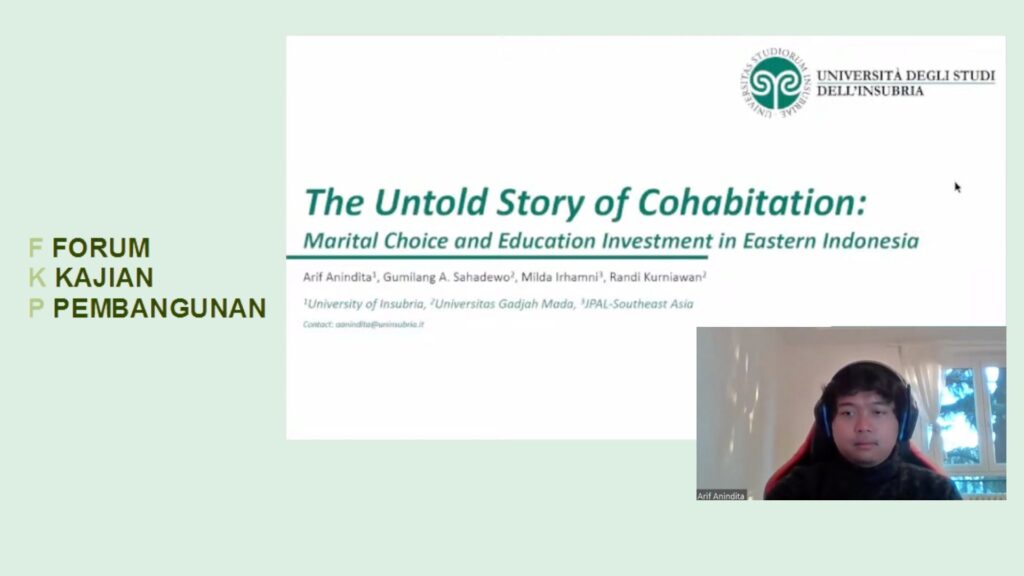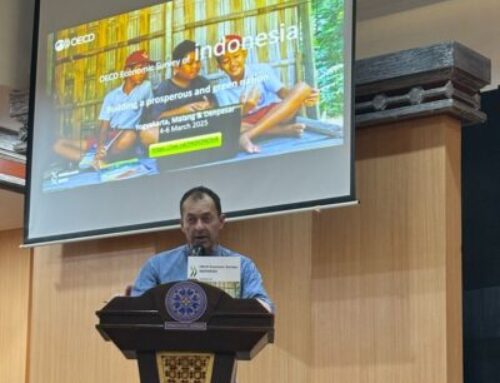FKP hosted by ANU Indonesia Project with Arif Anindita (Università degli Studi dell’Insubria, Italy). Tuesday, 30 November 2021.
KEY POINTS:
- In some communities in eastern Indonesia, couples can choose not to marry because of the expensive bride price. However, research has shown that cohabitation decisions have negative effects on children’s outcomes such as behavior, test scores, health, and psychology. This study utilizes the practice of cohabitation that is common in Eastern Indonesia to explore the effect of cohabitation on children’s cognitive development and its potential determinants.
- Preliminary findings from the study suggest that cohabitation has a negative effect on a child’s cognitive score and households’ spending on educational purposes. This potential decrease in children’s cognitive development can be explained by households sending their children to low quality school and the lack of school supplies provided for the children. Based on this finding, it is suggested that instead of punishing cohabiting families, policymakers should work on reducing barriers to marriage such as reducing the high bride price through a community movement and engaging with community leaders as they have a big influence on marriage decisions in the community.
SUMMARY
- In some communities in eastern Indonesia, couples can choose not to marry because of the expensive bride price. For example, in Kodi, Sumba the cost of a marriage ceremony (including the bride price) is approximately US$7,689 (236% Indonesian GDP per capita) and in Lamalohot, Flores it is around US$911-US$7,841 (75%-582% Indonesian GDP per capita). Couples with financial constraints delay their marriage and choose to live together and accumulate wealth that will enable them to pay bride price for a marriage in the future. However, research has shown that cohabitation decisions have negative effects on children’s outcomes such as behavior, test scores, health, and psychology. Despite the impact, couples in some communities are opting out of marriage because of the high costs of marriage. To investigate this issue further, Arif Anindita from the University of Insubria, Italy, conducted a study on marital choice and education investment in Eastern Indonesia. The study utilizes the practice of cohabitation that is common in Eastern Indonesia to explore the effect of cohabitation on children’s cognitive development and its potential determinants.
- This study uses data from the Indonesia Family Life Survey East Survey (2012) which includes 10,000 individuals living in 2,500 households. In the Survey, cognitive ability was measured using standardized Colored-Progressive-Matrices test and Mathematics test results by age group available at IFLS-East. Education spending is measured using the ratio between total education-related spending and total household spending. The instrument used in the study is having a non-marital son as a first child dummy. Meanwhile, the base value is the combination of having a non-marital daughter as first child, having marital children, and having no biological children. Why choose a non-marital son dummy as an instrument? Previous study in the United States shows that child gender has correlation with marital decision. Parents expect that boys (not girls) can contribute to the household economy by working, even as a child.
- Some of the main preliminary findings from the study are as follows: First, cohabitation has a negative effect on a child’s cognitive score and less spending on educational purposes. The results show that children from cohabitants have cognitive scores 0.288 ssd points lower than their peers. Also, cohabitant households spend 4.4 percentage points less on educational purposes. If compared to median expenditure, cohabitant households spend 1 million Rupiah less than married couples (On average, households spend 4.5 million on education expenditure yearly). Second, the potential decrease in a child’s cognitive development can be explained by households sending their children to low quality school and the lack of school supplies. The estimation provides similar results even after controlling Net Asset in the marriage entry phase. Furthermore, no significant result for other potential links of cohabitation on a child’s cognitive development.
- The research findings suggest that the negative impact of cohabitation in Eastern Indonesia is greater than the positive impact of providing high quality schools and increasing teacher quality. Cultural norms are one of the causes of cohabitation, which is quite difficult to solve. What are the policy implications of these findings? The researchers proposed that instead of punishing cohabit families, policymakers should work on reducing barriers to marriage. There are several potential interventions including reducing the high bride price through a community movement and engaging with community leaders as they have a big influence on marriage decisions in the community. Central Sumba government’s initiatives can be a good example where the district government collaborates with traditional community leaders to establish a community movement that reinterprets norms that have been misinterpreted such as the high bride price.





